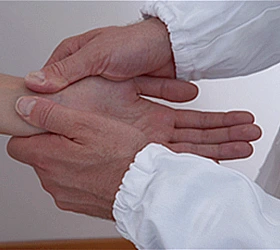Numbness and Tingling - Hands
Description
Numbness and tingling sensations may be sporadic or chronic. There may have been a slow gradual onset or it
may come on suddenly.
Sensory disturbances are divided into:
- paresthesias: spontaneous, abnormal sensations, described as “pins and needles” or tingling.
- dysethesias: irritating sensations evoked by normal stimuli such as light touch.

Causes
Plantar fasciitis typically presents as pain on the bottom of the foot, most commonly at the heel. The pain is often most intense with the first steps in
the morning. It is commonly exacerbated when flexing the foot toward the shin. While symptoms usually improve with walking, the pain may recur after prolonged standing or when rising from a seated position. Pain may also refer to the lower leg or knee.
Common causes of numbness and tingling in the hands:
- Metabolic disorders (diabetes, uremia etc.)
- Vertebral subluxation (malposition) in the cervical spine
- Herniated cervical disc
- Cervical nerve root irritation
- Peripheral nerve irritation or compression (shoulder, arm, hand)
- Ischemia (inadequate blood circulation)
- Muscle tension
- Myofascial trigger points
- Irritation of soft tissue: vertebral discs, joint capsules, muscles, tendons and ligaments
- Spinal canal or foraminal stenosis
- Muscle weakness
- Sedentary lifestyle
- Repetitive movement
- Hyperinsulinism / blood sugar handling
- Central nervous system disorders (multiple sclerosis, ALS etc.)
- Liver or kidney disease
- Tumor
- Alcohol or drug related
- Residual effects of trauma (whiplash, fracture etc.)
- Side effects of medication
- Anxiety or depression
- Problems with teeth (past dental work)
Chiropractic / Applied Kinesiology Approach to Numbness and Tingling Sensations
Sometimes the cause of numbness and tingling sensations is as simple as misalignments in the cervical spine. More often than not however there are several
contributing factors. It is therefore necessary to consider
the entire state of a patient’s health before proceeding
with therapy.
As a Chiropractor using Applied Kinesiology, Dr. Morrison
provides therapy that is based on the patient’s history, physical exam, and on clinical exams. As such, all three sides of the triad of health are addressed: structural, chemical and emotional.
Once the underlying causes of numbness have been identified and
symptoms have been successfully addressed, patients are offered guidance to help maintain their results. For some, this may involve ergonomic adjustments or dietary recommendations. For others, a combination of
nutritional supplementation and ongoing maintenance care may be
appropriate.




